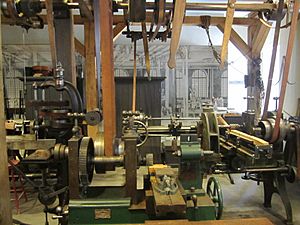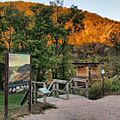Harpers Ferry Armory facts for kids

The Harpers Ferry Armory was a very important place where the United States government made weapons. It was the second armory built by the U.S. government. It was located in Harpers Ferry, West Virginia, which was part of Virginia back then. People sometimes called it the "mother arsenal." The first armory was in Springfield, Massachusetts. The Harpers Ferry Armory was involved in many big events in American history.
Contents
History
How Harpers Ferry Started
In 1751, a man named Robert Harper bought land where the Potomac River and Shenandoah River meet. He started a ferry service to help people cross the Shenandoah River. In 1763, the Virginia General Assembly officially created the town of "Shenandoah Falls" at "Mr. Harper's Ferry." Soon, it became known simply as Harpers Ferry. The town grew and became a busy place for travel and business.
Building the National Armory
In 1794, the United States Congress passed a law to build and fix armories and storage places for weapons. President George Washington chose Harpers Ferry for the new armory. In 1796, the U.S. government bought land from Robert Harper's family.
Building the armory began in 1799. Three years later, in 1802, they started making military weapons in large numbers. When it first opened, the armory had only one room and 25 workers. Even so, it produced many muskets, rifles, and later pistols. By 1810, the armory was making about 10,000 weapons each year. The machines in the armory were powered by the river's water.
Most of the guns used for the 1804 Lewis and Clark Expedition were made at Harpers Ferry. In 1811, Captain John Hall designed the M1819 Hall rifle. The U.S. Army started using this rifle in 1819, and it was made at Harpers Ferry.
Improving the Armory
In the 1830s and 1840s, the basic musket made at the armory changed. Stronger gunpowder was invented. Weapons also changed from using flintlocks to percussion caps. By 1855, the armory was making thousands of rifled muskets with "HARPERS FERRY" stamped on them.
Big improvements to the armory happened between 1845 and 1854. Seven new workshops were built, and 121 new machines were added. These new buildings were made of brick with iron frames and sheet metal roofs. They were called the "U.S. Musket Factory." The armory's canal was made wider to bring in more water, which gave the machines more power.
More people also came to work at the armory. The number of workers grew from 25 in 1802 to about 400 in 1859. Working conditions got a little better, but not much.
John Brown's Raid
In 1859, the armory became famous for a raid led by abolitionist John Brown. Brown wanted to start a slave revolt, but he failed. However, his raid made people in the South very worried. It also made the tension between the North and South much worse before the American Civil War began.
During the Civil War
On April 17, 1861, Virginia left the Union. At this point, the armory became a very important military target. The governor of Virginia wanted to take the valuable armory for the South. He knew that no Southern armory could make weapons as well as Harpers Ferry. He sent his militia to capture the armory before the Union Army could send enough troops to protect it.
When the Virginia militia was four miles away, Union Army Lieutenant Roger Jones sent an urgent message to Washington, DC. He explained the danger and asked for thousands of troops to defend Harpers Ferry. When he got no reply, he decided he had to act. On the night of April 18, 1861, Jones ordered his men to set fire to the armory. They burned over 15,000 muskets and all the ammunition stored there. Then, they quickly retreated across the bridge to Maryland.
However, the approaching Virginia militia put out the flames. They managed to save 4,000 muskets and all the machinery. The Confederates held the armory for the next three months. During this time, they moved the machinery to a Confederate armory in Fayetteville, North Carolina. Then, when the Confederates left in July, they set fire to the buildings again. The armory was destroyed and was never rebuilt.
Why the Location Was Difficult
Even though the armory was very important for military reasons, it was almost impossible to defend. The town and armory were surrounded by cliffs that were a thousand feet high. To defend Harpers Ferry, soldiers needed to place artillery (large guns) on all the high points around the city. Soldiers who were stationed there during the war often said it was a "godforsaken, stinking hole." The location of Harpers Ferry turned out to be a bad choice for military defense.
After the Civil War
After the Civil War, John Brown's Fort was the only building that survived the destruction by both the Confederates and the Union. This building was named after John Brown because of his famous raid on the Harpers Ferry Armory in 1859. The building had been the armory's fire engine station and guardhouse.
Images for kids
-
The burning of the United States arsenal at Harper's Ferry, 10 P.M. April 18, 1861, sketched by D. H. Strother.





